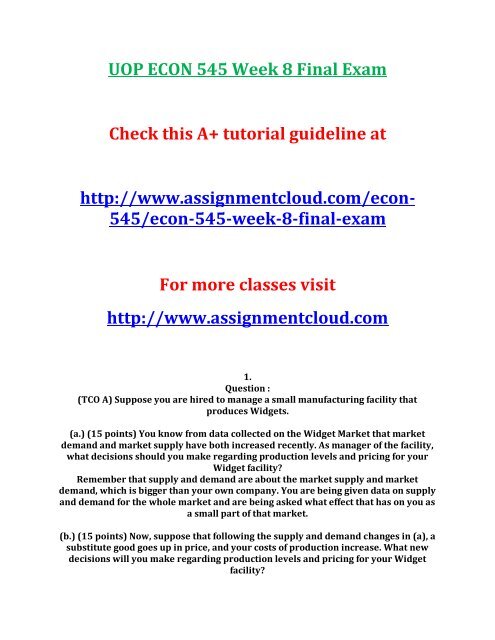UOP ECON 545 Week 8 Final Exam
econ/545 week 8,devry econ 545 week 8 dq 1,econ 545 week 8 dq 2,econ/545,devry econ/545,devry econ 545 week 8 final exam,econ 545 entire course,econ 545 final help
econ/545 week 8,devry econ 545 week 8 dq 1,econ 545 week 8 dq 2,econ/545,devry econ/545,devry econ 545 week 8 final exam,econ 545 entire course,econ 545 final help
Create successful ePaper yourself
Turn your PDF publications into a flip-book with our unique Google optimized e-Paper software.
<strong>UOP</strong> <strong>ECON</strong> <strong>545</strong> <strong>Week</strong> 8 <strong>Final</strong> <strong>Exam</strong><br />
Check this A+ tutorial guideline at<br />
http://www.assignmentcloud.com/econ-<br />
<strong>545</strong>/econ-<strong>545</strong>-week-8-final-exam<br />
For more classes visit<br />
http://www.assignmentcloud.com<br />
1.<br />
Question :<br />
(TCO A) Suppose you are hired to manage a small manufacturing facility that<br />
produces Widgets.<br />
(a.) (15 points) You know from data collected on the Widget Market that market<br />
demand and market supply have both increased recently. As manager of the facility,<br />
what decisions should you make regarding production levels and pricing for your<br />
Widget facility?<br />
Remember that supply and demand are about the market supply and market<br />
demand, which is bigger than your own company. You are being given data on supply<br />
and demand for the whole market and are being asked what effect that has on you as<br />
a small part of that market.<br />
(b.) (15 points) Now, suppose that following the supply and demand changes in (a), a<br />
substitute good goes up in price, and your costs of production increase. What new<br />
decisions will you make regarding production levels and pricing for your Widget<br />
facility?
2.<br />
Question :<br />
(TCO B) Here is some data on the demand for marshmallows:<br />
Price Quantity<br />
$10 100<br />
$ 8 300<br />
$ 6 700<br />
$ 4 1300<br />
$ 2 2200<br />
(a.) (15 points) Is demand elastic or inelastic in the $6-$8 price range? How do you<br />
know?<br />
(b.) (15 points) If the table represents the demand faced by a monopoly firm, then<br />
what is that firm’s marginal revenue as it increases output from 1300 units to 2200<br />
units? Show all work. (Be careful here!)<br />
3.<br />
Question :<br />
(TCO C) You have been hired to manage a small manufacturing facility whose cost<br />
and production data are given in the table below.<br />
Total Total<br />
Workers Labor Cost Output Revenue<br />
1 $500 100 $700<br />
2 1000 280 1150<br />
3 1500 440 1440<br />
4 2000 540 1570<br />
5 2500 600 1670<br />
6 3000 630 1710<br />
7 3500 640 1730<br />
(a.) (6 points) What is the marginal product of the second worker?<br />
(b.) (6 points) What is the marginal revenue product of the fourth worker?<br />
(c.) (6 points) What is the marginal cost of the first worker?<br />
(d.) (12 points) Based on your knowledge of marginal analysis, how many workers<br />
should you hire? Explain you answer.<br />
4.<br />
Question :<br />
(TCO C) Answer the next questions on the basis of the following cost data for a firm in<br />
pure competition:<br />
OUTPUT ------ TFC ---------- TVC<br />
0 $100.00 0.00
1 100.00 70.00<br />
2 100.00 120.00<br />
3 100.00 150.00<br />
4 100.00 200.00<br />
5 100.00 270.00<br />
6 100.00 360.00<br />
(a.) (15 points) Refer to the above data. If the product price is $45 at its optimal<br />
output, will the firm realize an economic profit, break even, or incur an economic<br />
loss? How much will the profit or loss be? Show all calculations.<br />
(b.) (15 points) Refer to the above data. If the product price is $75 at its optimal<br />
output, will the firm realize an economic profit, break even, or incur an economic<br />
loss? How much will the profit or loss be? Show all calculations.<br />
5.<br />
Question :<br />
(TCO D) A software producer has fixed costs of $18,000 per month and her Total<br />
Variable Costs (TVC) as a function of output Q are given below:<br />
Q TVC Price<br />
1,000 $15,000 $25<br />
2,000 20,000 24<br />
3,000 30,000 23<br />
4,000 50,000 22<br />
5,000 80,000 20<br />
(a.) (15 points) If software can only be produced in the quantities above, what should<br />
be the production level if the producer operates in a monopolistic competitive<br />
market where the price of software at each possible quantity is also listed above?<br />
Why? (Show all work).<br />
(b.) (15 points) What should be the production level if fixed costs rose to $48,000 per<br />
month? Explain.<br />
6.<br />
Question :<br />
(TCO F)<br />
(a.) (20 points) Suppose nominal GDP in 1999 was $200 billion, and in 2001, it was<br />
$270 billion. The general price index in 1999 was 100 and in 2001 it was 150.<br />
Between 1999 and 2001, the real GDP rose by what percent?<br />
(b.) Use the following scenario to answer questions (b1) and (b2).<br />
In a given year in the United States, the total number of residents is 270 million, the<br />
number of residents under the age of 16 is 38 million, the number of<br />
institutionalized adults is 15 million, the number of adults who are not looking for<br />
work is 17 million, and the number of unemployed is 10 million.
(b1.) (5 points) Refer to the data in the above scenario. What is the size of the labor<br />
force in the United States for the given year?<br />
(b2.) (5 points) Refer to the data in the above scenario. What is the unemployment<br />
rate in the United States for the given year?<br />
7.<br />
Question :<br />
(TCO G and H)<br />
(a.) (15 points) Suppose your local Congress representative suggests that the federal<br />
government intervenes in the gasoline market to stop runaway price increases.<br />
Would you say that this view basically supports the Keynesian or the Monetarist<br />
school of thought? Why? What position would the opposing school of thought take on<br />
this issue? (Be brief -- you can answer this in 2 or 3 brief paragraphs).<br />
(b.) (10 points) Any change in the economy’s total expenditures would be expected<br />
to translate into a change in GDP that was larger than the initial change in spending.<br />
This phenomenon is known as the multiplier effect. Explain how the multiplier effect<br />
works.<br />
(c.) (15 points) You are told that 90 cents out of every extra dollar pumped into the<br />
economy goes toward consumption (as opposed to saving). Estimate the GDP impact<br />
of a positive change in government spending that equals $20 billion.<br />
8.<br />
Question :<br />
(TCO G)<br />
(a.) (20 points) Third National Bank is fully loaned up with reserves of $20,000 and<br />
demand deposits equal to $100,000. The reserve ratio is 20%. Households deposit<br />
$5,000 in currency into the bank. How much excess reserves does the bank now<br />
have, and what is the maximum amount of new money that can be created in the<br />
banking system as a result of this deposit? Show all work.<br />
(b.) (20 points) What is the discount rate in the banking system? Explain how the Fed<br />
manipulates this rate to achieve macroeconomic objectives.

















